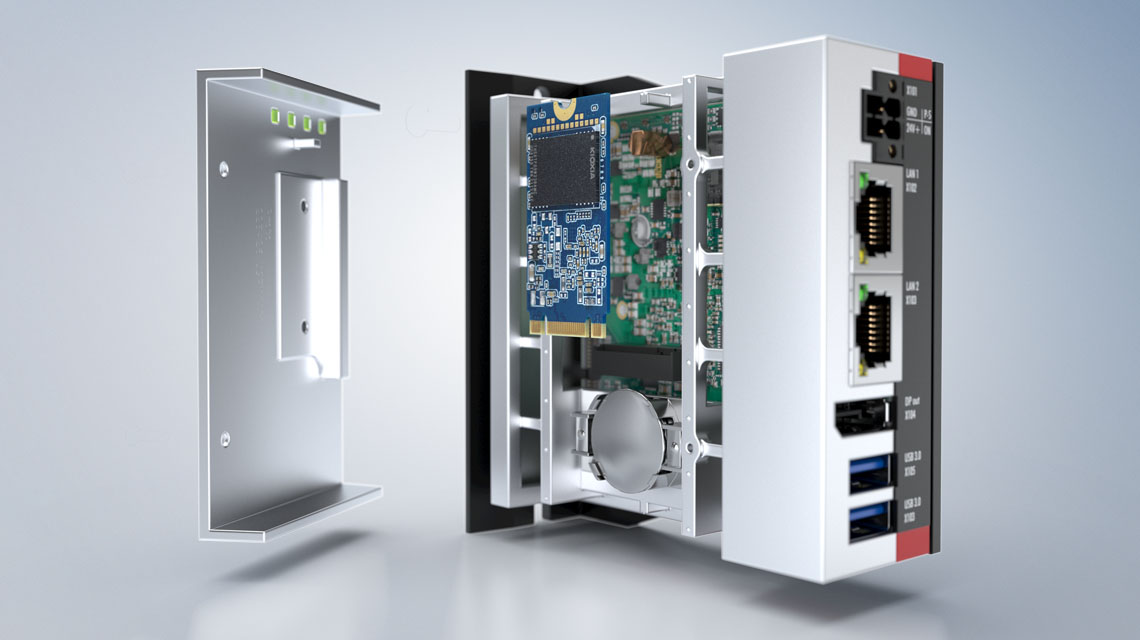
The industrial SSDs (solid-state drives) from Beckhoff deliver maximum reliability for data storage in challenging operating environments. In the industrial environment, 3D TLC NAND has established itself as the standard for secure data retention. In order to achieve even higher reliability and greater performance from the SSDs, Beckhoff uses 3D TLC flash memory via firmware configuration in pSLC mode.
pSLC mode gives the SSDs and CFast cards a long service life with over 50,000 write cycles. This means that the full capacity of the SSD can be written and erased fully up to 50,000 times before the data retention time drops to one year. Furthermore, the write speeds are optimized, resulting in faster data processing. This speed can be optimally utilized by the NVMe integration via the PCIe interface, as this offers significantly higher transmission rates compared to conventional SATA interfaces. While the SATA interface transmits data at up to 500 MB/s, NVMe SSDs connected to PCIe Generation 4 achieve read and write speeds of up to 6000 MB/s.
In contrast to SSDs in pSLC mode, the established 3D TLC NAND only achieves 2200 write cycles of the memory cells before the data retention time drops to one year. A write cycle describes the process in which a flash memory cell is written with a bit state and erased. At the beginning of the service life, the data retention time of the memory cells is up to ten years, but it decreases continuously with each subsequent write cycle. Using pSLC mode in Beckhoff Industrial PCs makes the service life of the memory cells up to 17 times longer and ensures reliable and long-term data retention.
Further advantages of industrial memory devices
- long-term data retention time for reliable data storage
- reduced susceptibility to data errors due to loss of charge or interference between the memory cells
- reliable detection of bit states thanks to pSLC memory architecture
- powerful error correction algorithms for data integrity
- outstanding speeds thanks to 1-bit memory architecture
- NVMe software protocol: direct communication between SSD and CPU for maximum performance
- lower latency times: improved response time and system performance
- 3D memory architecture: optimum memory densities for space-saving designs
- over 50,000 P/E cycles to ensure a long service life with high write performance
- High-performance flash memory controllers ensure consistent functionality of the memory cells through intelligent wear leveling.
- no rotating parts means no mechanical failures or data loss
- minimized downtime: improved system availability and productivity
- Memory devices with pSLC memory architecture are the optimum solution for applications with high demands on system performance and service life.
- ideal for applications with high data rates, such as image processing, machine control, and data acquisition
- a robust solution for harsh industrial environments: extended temperature range along with high shock and vibration resistance
- The pSLC memory architecture is the perfect solution when the exact write load of the application is unknown: ‘stress-free flash’.
Industrial SSDs from Beckhoff offer unparalleled reliability, maximum performance, and an outstanding service life. They are the ideal choice for use in demanding industrial environments and applications that need maximum data availability and system performance.
Industrial PCs with industrial memory devices

Panel PCs
The Beckhoff Panel PCs, in the versions as built-in devices or mounting arm devices in IP65, combine modern touch technologies with flexible computing power.

PCs
With self-developed and produced motherboards, the Beckhoff Industrial PCs combine performance with flexibility, stability, and long-term availability.